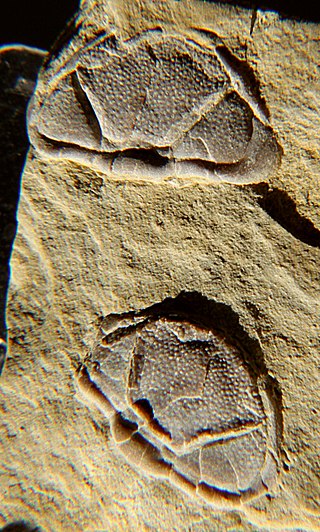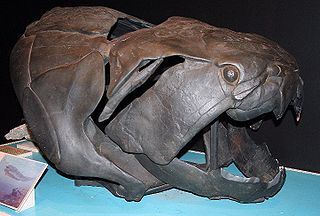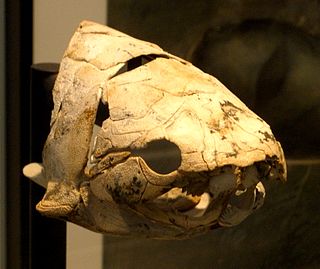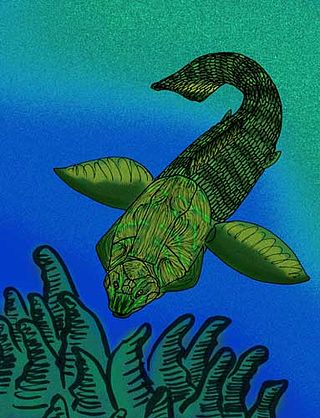
The Devonian is a geologic period and system of the Paleozoic era during the Phanerozoic eon, spanning 60.3 million years from the end of the preceding Silurian period at 419.2 million years ago (Ma), to the beginning of the succeeding Carboniferous period at 358.9 Ma. It is named after Devon, South West England, where rocks from this period were first studied.

Elasmobranchii is a subclass of Chondrichthyes or cartilaginous fish, including modern sharks, rays, skates, and sawfish. Members of this subclass are characterised by having five to seven pairs of gill clefts opening individually to the exterior, rigid dorsal fins and small placoid scales on the skin. The teeth are in several series; the upper jaw is not fused to the cranium, and the lower jaw is articulated with the upper. The details of this jaw anatomy vary between species, and help distinguish the different elasmobranch clades. The pelvic fins in males are modified to create claspers for the transfer of sperm. There is no swim bladder; instead, these fish maintain buoyancy with large livers rich in oil.

The Late Devonian extinction consisted of several extinction events in the Late Devonian Epoch, which collectively represent one of the five largest mass extinction events in the history of life on Earth. The term primarily refers to a major extinction, the Kellwasser event, also known as the Frasnian-Famennian extinction, which occurred around 372 million years ago, at the boundary between the Frasnian stage and the Famennian stage, the last stage in the Devonian Period. Overall, 19% of all families and 50% of all genera became extinct. A second mass extinction called the Hangenberg event, also known as the end-Devonian extinction, occurred 359 million years ago, bringing an end to the Famennian and Devonian, as the world transitioned into the Carboniferous Period.
The Givetian is one of two faunal stages in the Middle Devonian Period. It lasted from 387.7 million years ago to 382.7 million years ago. It was preceded by the Eifelian Stage and followed by the Frasnian Stage. It is named after the town of Givet in France. The oldest forests occurred during the late Givetian. The lower GSSP is located at Jebel Mech Irdane, Tafilalt, Morocco.

Dunkleosteus is an extinct genus of large arthrodire ("jointed-neck") fish that existed during the Late Devonian period, about 382–358 million years ago. It was a pelagic fish inhabiting open waters, and one of the first apex predators of any ecosystem.

The Frasnian is one of two faunal stages in the Late Devonian Period. It lasted from 382.7 million years ago to 372.2 million years ago. It was preceded by the Givetian Stage and followed by the Famennian Stage.

Xenacanthida is an order or superorder of extinct shark-like chondrichthyans known from the Carboniferous to Triassic. They were native to freshwater, marginal marine and shallow marine habitats. Some xenacanths may have grown to lengths of 5 m (16 ft). Most xenacanths died out at the end of the Permian in the End-Permian Mass Extinction, with only a few forms surviving into the Triassic.

Chotecops is a genus of trilobites from the order Phacopida, suborder Phacopina, family Phacopidae. It was initially erected as a subgenus of Phacops but some later authors thought it distinctive enough to raise its status. Species assigned to this genus occur between the Emsian and the Famennian. Chotecops is the most abundant trilobite in the Hunsrück Slate and due to the excellent preservation, often soft tissue such as antennae and legs have been preserved as a thin sheet of pyrite.

Trimerocephalus is a genus of eyeless trilobites from the order Phacopida, family Phacopidae. It lived during the final stage of the Devonian, the Famennian, and became extinct at the end of this stage, together with all other trilobites with the exception of some Proetida. It can be found in Australia, the Czech Republic, France, Germany, Iran, Kazakhstan, Morocco, Poland, the Russian Federation (Urals), Spain, and the United Kingdom (England).

Dunkleosteidae is an extinct family of arthrodire placoderms that lived during the Devonian period. The gigantic apex predator Dunkleosteus terrelli is the best known member of this group.
The Hangenberg event, also known as the Hangenberg crisis or end-Devonian extinction, is a mass extinction that occurred at the end of the Famennian stage, the last stage in the Devonian Period. It is usually considered the second-largest extinction in the Devonian Period, having occurred approximately 13 million years after the Late Devonian mass extinction at the Frasnian-Famennian boundary. The event is named after the Hangenberg Shale, which is part of a sequence that straddles the Devonian-Carboniferous boundary in the Rhenish Massif of Germany.

Holonema is an extinct genus of relatively large, barrel-shaped arthrodire placoderms that were found in oceans throughout the world from the Mid to Late Devonian, when the last species perished in the Frasnian-Fammian extinction event. Most species of the genus are known from fragments of their armor, but the Gogo Reef species, H. westolli, is known from whole, articulated specimens.

Eastmanosteus is a fossil genus of dunkleosteid placoderms. It was closely related to the giant Dunkleosteus, but differed from that genus in size, in possessing a distinctive tuberculated bone ornament, a differently shaped nuchal plate and a more zig-zagging course of the sutures of the skull roof.

Holonematidae is an extinct family of relatively large arthrodire placoderms from the Early to Late Devonian. Almost all fossil specimens are of armor fragments, though, all have distinctive ornamentation, often of unique arrangements and patterns of tubercles, that are diagnostic of the family. The trunkshield is very elongated, giving the armor an overall "barrel" like appearance.

Antarctilamna is an extinct genus of Devonian cartilaginous fish originally exemplified by Antarctilamna prisca from South Eastern Australia and Antarctica. The latest occurring described species is Antarctilamna ultima from the Waterloo Farm lagerstätte in South Africa. Antarctilamna has robust ctenacanthid-like spines which lack a deep insertion area, and are borne in front of the first dorsal fin; in addition to distinctive diplodont teeth with small intermediate cusps. Antarctilamna-like spines, known from the Bunga Beds locality in Australia have been ascribed to A. prisca.

Thrinacodus is an extinct genus of basal elasmobranch, found worldwide from the Late Devonian-Lower Carboniferous. The type species is Thrinacodus nanus. Most species are only known from their tricuspid teeth. T. gracia, originally placed in the separate genus Thrinacoselache from the Serpukhovian-aged Bear Gulch Limestone, of what is now Montana, is known from full body impressions, showing a long, slender eel-like body up to a metre in length, with an elongate rostrum. Stomach contents of T. gracia include remains of crustaceans and small chondrichthyan fish. It is a member of the Phoebodontiformes.
This list of fossil fishes described in 2019 is a list of new taxa of jawless vertebrates, placoderms, acanthodians, fossil cartilaginous fishes, bony fishes, and other fishes of every kind that were described during the year 2019, as well as other significant discoveries and events related to paleoichthyology that occurred in 2019.
Arduodens is an extinct genus of ctenacanth fish from the Devonian period. Its name is derived from the Latin Arduus meaning steep and dens meaning tooth. It is currently known from a singular species, A. flammeus. It was described from isolated cladodont teeth found in deposits from the upper Frasnian to lower Fammenian of central Iran. The specific epithet is derived from the Latin for "flamming."

Ctenacanthiformes is an extinct order of cartilaginous fish. They possessed ornamented fin spines at the front of their dorsal fins and cladodont-type dentition, that is typically of a grasping morphology, though some taxa developed cutting and gouging tooth morphologies. Some ctenacanths are thought to have reached sizes comparable to the great white shark, with body lengths of up to 7 metres (23 ft) and weights of 1,500–2,500 kilograms (3,300–5,500 lb). The earliest ctenacanths appeared during the Frasnian stage of the Late Devonian, with the group reaching their greatest diversity during the Early Carboniferous (Mississippian), and continued to exist into at least the Middle Permian (Guadalupian). Some authors have suggested members of the family Ctenacanthidae may have survived into the Cretaceous based on teeth found in deep water deposits of Valanginian age in France and Austria, however, other authors contend that the similarity of these teeth to Paleozoic ctenacanths is only superficial, and they likely belong to neoselachians instead.

Phoebodontiformes is an extinct group of elasmobranchs, known from the Devonian and Carboniferous periods. It includes the genera Phoebodus, Diademodus and Thrinacodus. Phoebodus and Thrinacodus have slender, elongate bodies. Their teeth are tricuspate. Some studies have recovered the group as paraphyletic.

















